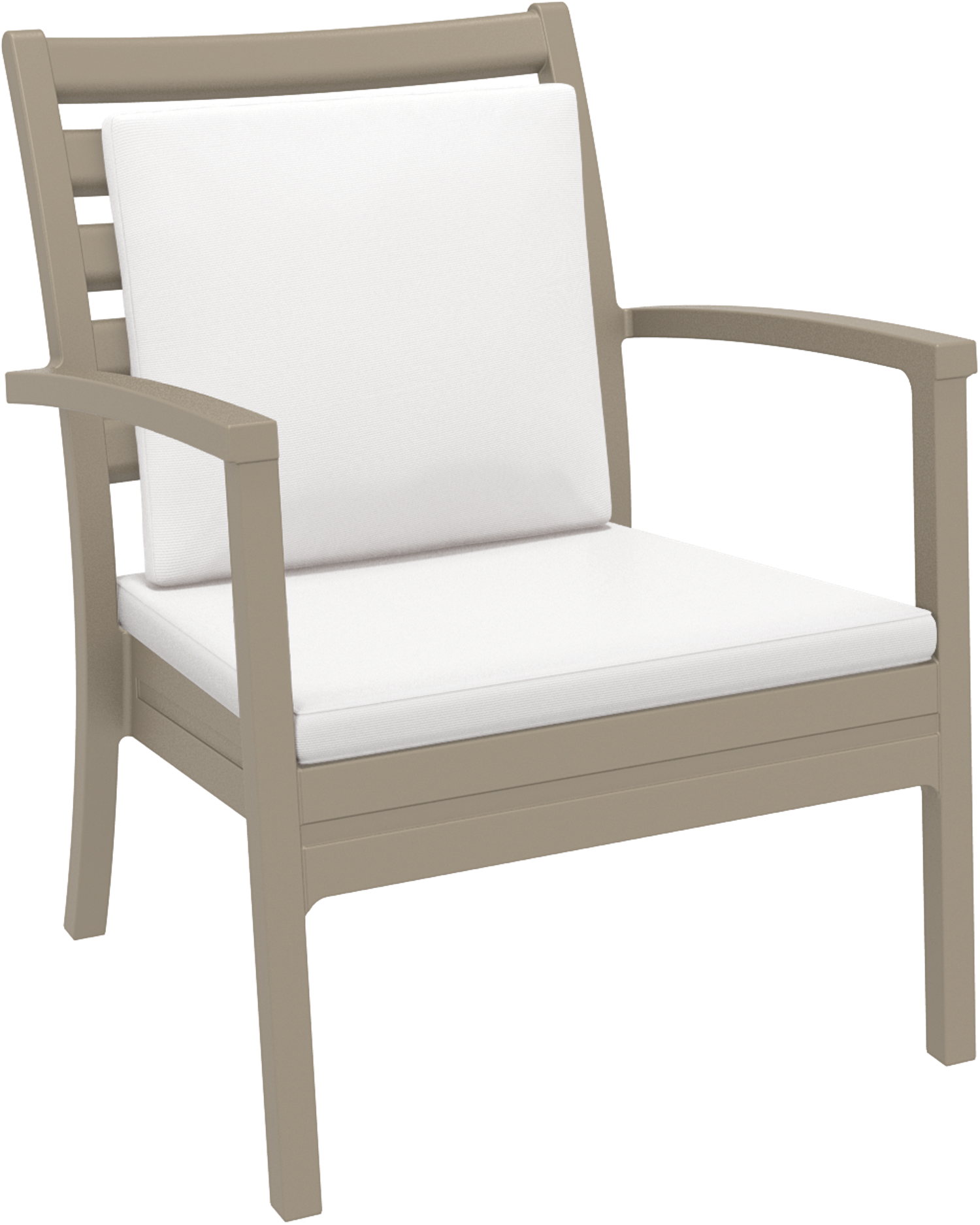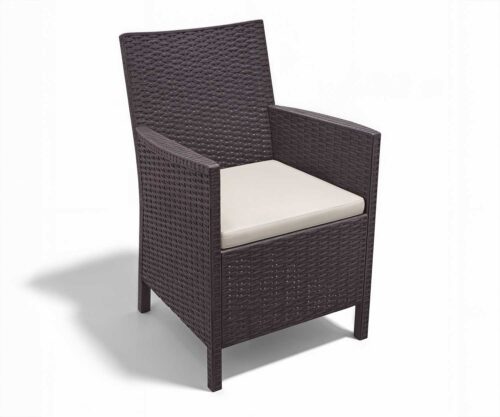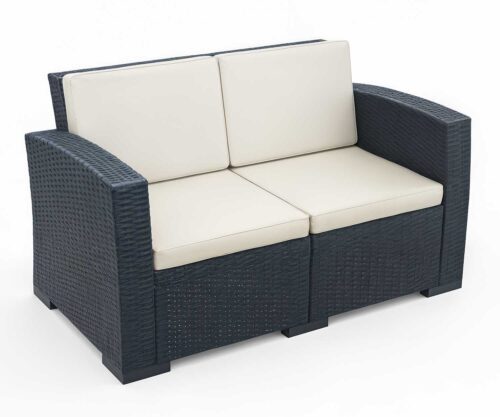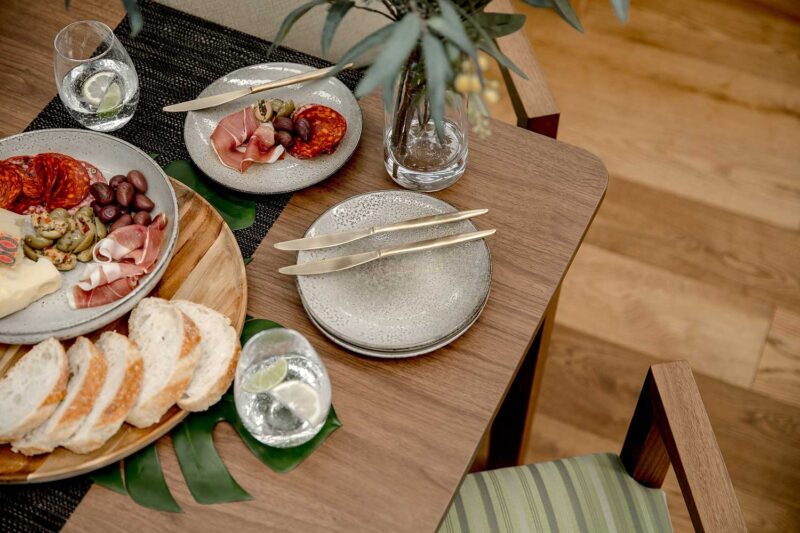[Practical Design Tips] How to Design Outdoor Spaces That Aged Care Residents Love

Creating outdoor spaces in aged care facilities is not just about adding a few benches and planters—it’s about designing environments that encourage residents to connect with nature, socialise, and truly enjoy their time outside. Yet, all too often, these areas remain underused. Why is this the case, and how can we create outdoor retreats that truly entice residents to venture out and linger?
In this article, we’ll explore ways to turn those aged care outdoor areas into inviting, vibrant spaces that residents genuinely want to escape to.
1. Prioritising Comfort Above All
Imagine a garden that looks beautiful but has rigid, uncomfortable furniture. Residents may stroll by it occasionally, but they’re unlikely to stay long. Comfort is a top priority, and aged care outdoor furniture should reflect that. Plush, supportive seating made from UV stabilised, weather resistant materials, with outdoor cushions can transform outdoor time into a pleasure. Comfort isn’t just about cushions—it’s also about ergonomic designs, armrests, and seating options that are accessible for those with limited mobility.Practical Tips:
- Choose furniture with ample padding: Weather-resistant cushions or soft mesh chairs with lumbar support make seating more comfortable.
- Add reclining options: Provide recliners or adjustable seating so residents can find their preferred posture.
- Incorporate armrests and high backs: These features make it easier for residents to sit down and stand up, ensuring comfort and accessibility.
- Consider side tables for personal items: Small tables near seating areas allow residents to place drinks, books, or reading glasses within reach.
- Place furniture in shaded areas: This will help residents enjoy outdoor spaces even during sunny days without worrying about overheating.
2. Creating Zones for Different Needs
An effective outdoor space caters to various activities by creating distinct areas. These zones allow residents to select the type of experience they want—whether quiet relaxation or engaging socialisation.Practical Tips:
- Create a private corner with foliage or screens: Use shrubs, trellises, or partitions to form quiet areas for reflection.
- Arrange chairs in a circle for socialising: Place chairs in circular formations to encourage interaction in group areas.
- Add tables and chairs for activities: Use sturdy, adjustable-height tables that can accommodate board games, crafts, or even gardening.
- Design a walking path loop: Paved walkways around the zones offer a safe place for gentle exercise or strolls.
- Incorporate flexible seating: Portable or stackable chairs allow staff to adjust seating arrangements based on resident preferences and activities.
3. Incorporating Familiar and Nostalgic Touches
Nostalgia can be incredibly powerful, especially for residents who may feel a sense of loss or disconnection. Adding familiar or nostalgic elements, such as vintage chairs, porch swings, or even bird feeders, can provide a comforting sense of “home.” These touches tap into pleasant memories, allowing residents to feel emotionally connected to the space.Practical Tips:
- Use rocking chairs or porch swings: These timeless pieces are associated with relaxation and home comfort, inviting residents to linger.
- Place bird feeders and birdbaths: These attract birds and add an interactive, lively element that many residents enjoy watching.
- Set up a sensory garden with nostalgic plants: Include herbs, flowers, or plants like lavender, rosemary, or roses that might remind residents of home gardens.
- Install garden art or statues: Choose art that might resonate with residents, such as vintage or nature-themed pieces.
- Encourage family members to add small personal touches: Family-donated plants, photos, or decorations (as appropriate) can add a personal touch and make the space feel more homely.
4. Focus on Natural Elements and Sensory Engagement
The sensory experience of an outdoor space has an enormous impact on its appeal. Think about elements that engage multiple senses and create a soothing, restorative environment. Features like water fountains, fragrant flowers, wind chimes, and natural textures in furniture and decor can transform a space from utilitarian to immersive.Practical Tips:
- Add water features for calming sounds: Fountains or small ponds can add soothing background noise and enhance the sensory appeal.
- Include fragrant flowers: Flowers like lavender, jasmine, or honeysuckle add beautiful aromas that can be uplifting or relaxing.
- Opt for tactile furniture materials: Use wicker, wood, or other textured materials that feel natural and warm to the touch.
- Add raised herb gardens: Plant herbs like mint, basil, and thyme, allowing residents to touch and even taste them with supervision.
- Incorporate gentle, coloured lighting: String lights, lanterns, or solar lights add warmth and visibility for evening enjoyment.
5. Make It Accessible, Safe, and Shade-Friendly
For aged care residents, accessibility is paramount. All pathways should be smooth, level, and wide enough to accommodate walkers or wheelchairs. Outdoor furniture should be sturdy and easy to get in and out of, with armrests and back support. Additionally, shaded areas are essential for keeping the space usable throughout the day, especially during warmer months.Practical Tips:
- Install slip-resistant, even flooring: Smooth surfaces like concrete or composite wood ensure safe navigation for walkers and wheelchairs.
- Add handrails along pathways: Handrails provide extra support, especially on slopes or longer paths.
- Place furniture in shaded areas or under pergolas: Ensure seating is placed in areas with adequate shade, either naturally or with covers like awnings or pergolas.
- Use non-glare surfaces: Non-reflective materials for tables and seating reduce eye strain for residents with sensitive vision.
- Incorporate high-contrast pathways and steps: Clear visual distinctions between walking paths and garden beds help residents safely navigate the space.
6. Adding Personalisation Options for Residents
Allowing residents to add personal touches to their outdoor areas can make them feel more connected to the space. A small herb garden, a birdhouse they can paint, or a planter box to tend are great ways to offer ownership and foster a sense of purpose.
Practical Tips:
- Offer planter boxes for personal gardening: Allow residents to select plants and tend to their own small garden areas.
- Create a “resident art wall”: Dedicate a section for resident-painted pots or small outdoor art that can be changed periodically.
- Use adjustable seating configurations: Let residents choose seating arrangements that feel best for them, whether for socialising or solitude.
- Encourage family participation in decor: Invite families to add small, weather-resistant mementos like wind chimes or miniature birdhouses.
- Let residents suggest features: Hold regular meetings where residents can share ideas for outdoor activities or items to add to the space.
7. Designing for Year-Round Usability
The best outdoor spaces are those that can be enjoyed in every season. For facilities in colder climates, consider heating options like portable outdoor heaters or covered seating areas to protect from wind and rain. In warmer months, add fans or misters to make the space more comfortable. Year-round usability maximises the investment in outdoor furniture and gives residents consistent access to fresh air and nature.
Practical Tips:
- Install outdoor heaters for colder months: Place infrared or propane heaters near seating to extend the space’s usability through fall and winter.
- Add movable sun shades: Adjustable umbrellas or retractable awnings offer flexible shade for hotter days.
- Use water-resistant furniture materials: Teak, treated wicker, and powder-coated metals withstand moisture, ensuring furniture durability year-round.
- Consider heated paving for winter safety: If feasible, heated pathways can help prevent ice buildup and make walking paths safe in cooler climates.
- Include blankets and weatherproof cushions: Outdoor-friendly throws and cushions add warmth and comfort in colder weather, encouraging residents to stay longer.
8. Incorporate Technology Thoughtfully
While nature should be the focus, a light touch of technology can enhance the experience. Bluetooth speakers for calming music, USB ports for residents to charge devices, or even a few outdoor lights can add functionality without overwhelming the natural feel. In some cases, tech can make the outdoor retreat more accessible—for instance, audio guides for residents with visual impairments, or an intercom for those who need to contact staff.
Practical Tips:
- Install subtle outdoor speakers: Play nature sounds or soft music to create an inviting atmosphere without disrupting the natural ambience.
- Use motion-sensor lights for evening safety: Lighting that activates when residents enter an area ensures visibility without the need for manual adjustments.
- Provide charging stations: Simple, discreet USB or power outlets let residents recharge phones or devices.
- Add an outdoor intercom system: This can allow residents to communicate with staff easily if they need assistance.
- Consider video doorbells or cameras: For larger outdoor spaces, gentle monitoring can ensure residents’ safety without being intrusive.
Creating Spaces That Residents Want to Use
Designing outdoor spaces that genuinely attract aged care residents requires more than just aesthetics—it’s about creating areas that feel comforting, safe, and engaging. By focusing on comfort, accessibility, sensory engagement, and personalisation, facility managers can create outdoor spaces that are a joy to escape to. The right furniture is key, transforming an ordinary garden into a true outdoor retreat that invites residents to connect, relax, and enjoy the beauty of the outdoors.
These small yet thoughtful choices make all the difference, encouraging residents to make the most of their time outside and bringing fresh air and new experiences into their daily lives.
Aged Care Outdoor Furniture
Our range of UV-stabilised, weather-resistant furniture is crafted to withstand Australia’s unique climate, offering durable, stylish comfort for any commercial outdoor setting.
More News
[Practical Design Tips] How to Design Outdoor Spaces That Aged Care Residents Love

Creating outdoor spaces in aged care facilities is not just about adding a few benches and planters—it’s about designing environments that encourage residents to connect with nature, socialise, and truly enjoy their time outside. Yet, all too often, these areas remain underused. Why is this the case, and how can we create outdoor retreats that truly entice residents to venture out and linger?
In this article, we’ll explore ways to turn those aged care outdoor areas into inviting, vibrant spaces that residents genuinely want to escape to.
1. Prioritising Comfort Above All
Imagine a garden that looks beautiful but has rigid, uncomfortable furniture. Residents may stroll by it occasionally, but they’re unlikely to stay long. Comfort is a top priority, and aged care outdoor furniture should reflect that. Plush, supportive seating made from UV stabilised, weather resistant materials, with outdoor cushions can transform outdoor time into a pleasure. Comfort isn’t just about cushions—it’s also about ergonomic designs, armrests, and seating options that are accessible for those with limited mobility.Practical Tips:
- Choose furniture with ample padding: Weather-resistant cushions or soft mesh chairs with lumbar support make seating more comfortable.
- Add reclining options: Provide recliners or adjustable seating so residents can find their preferred posture.
- Incorporate armrests and high backs: These features make it easier for residents to sit down and stand up, ensuring comfort and accessibility.
- Consider side tables for personal items: Small tables near seating areas allow residents to place drinks, books, or reading glasses within reach.
- Place furniture in shaded areas: This will help residents enjoy outdoor spaces even during sunny days without worrying about overheating.
2. Creating Zones for Different Needs
An effective outdoor space caters to various activities by creating distinct areas. These zones allow residents to select the type of experience they want—whether quiet relaxation or engaging socialisation.Practical Tips:
- Create a private corner with foliage or screens: Use shrubs, trellises, or partitions to form quiet areas for reflection.
- Arrange chairs in a circle for socialising: Place chairs in circular formations to encourage interaction in group areas.
- Add tables and chairs for activities: Use sturdy, adjustable-height tables that can accommodate board games, crafts, or even gardening.
- Design a walking path loop: Paved walkways around the zones offer a safe place for gentle exercise or strolls.
- Incorporate flexible seating: Portable or stackable chairs allow staff to adjust seating arrangements based on resident preferences and activities.
3. Incorporating Familiar and Nostalgic Touches
Nostalgia can be incredibly powerful, especially for residents who may feel a sense of loss or disconnection. Adding familiar or nostalgic elements, such as vintage chairs, porch swings, or even bird feeders, can provide a comforting sense of “home.” These touches tap into pleasant memories, allowing residents to feel emotionally connected to the space.Practical Tips:
- Use rocking chairs or porch swings: These timeless pieces are associated with relaxation and home comfort, inviting residents to linger.
- Place bird feeders and birdbaths: These attract birds and add an interactive, lively element that many residents enjoy watching.
- Set up a sensory garden with nostalgic plants: Include herbs, flowers, or plants like lavender, rosemary, or roses that might remind residents of home gardens.
- Install garden art or statues: Choose art that might resonate with residents, such as vintage or nature-themed pieces.
- Encourage family members to add small personal touches: Family-donated plants, photos, or decorations (as appropriate) can add a personal touch and make the space feel more homely.
4. Focus on Natural Elements and Sensory Engagement
The sensory experience of an outdoor space has an enormous impact on its appeal. Think about elements that engage multiple senses and create a soothing, restorative environment. Features like water fountains, fragrant flowers, wind chimes, and natural textures in furniture and decor can transform a space from utilitarian to immersive.Practical Tips:
- Add water features for calming sounds: Fountains or small ponds can add soothing background noise and enhance the sensory appeal.
- Include fragrant flowers: Flowers like lavender, jasmine, or honeysuckle add beautiful aromas that can be uplifting or relaxing.
- Opt for tactile furniture materials: Use wicker, wood, or other textured materials that feel natural and warm to the touch.
- Add raised herb gardens: Plant herbs like mint, basil, and thyme, allowing residents to touch and even taste them with supervision.
- Incorporate gentle, coloured lighting: String lights, lanterns, or solar lights add warmth and visibility for evening enjoyment.
5. Make It Accessible, Safe, and Shade-Friendly
For aged care residents, accessibility is paramount. All pathways should be smooth, level, and wide enough to accommodate walkers or wheelchairs. Outdoor furniture should be sturdy and easy to get in and out of, with armrests and back support. Additionally, shaded areas are essential for keeping the space usable throughout the day, especially during warmer months.Practical Tips:
- Install slip-resistant, even flooring: Smooth surfaces like concrete or composite wood ensure safe navigation for walkers and wheelchairs.
- Add handrails along pathways: Handrails provide extra support, especially on slopes or longer paths.
- Place furniture in shaded areas or under pergolas: Ensure seating is placed in areas with adequate shade, either naturally or with covers like awnings or pergolas.
- Use non-glare surfaces: Non-reflective materials for tables and seating reduce eye strain for residents with sensitive vision.
- Incorporate high-contrast pathways and steps: Clear visual distinctions between walking paths and garden beds help residents safely navigate the space.
6. Adding Personalisation Options for Residents
Allowing residents to add personal touches to their outdoor areas can make them feel more connected to the space. A small herb garden, a birdhouse they can paint, or a planter box to tend are great ways to offer ownership and foster a sense of purpose.
Practical Tips:
- Offer planter boxes for personal gardening: Allow residents to select plants and tend to their own small garden areas.
- Create a “resident art wall”: Dedicate a section for resident-painted pots or small outdoor art that can be changed periodically.
- Use adjustable seating configurations: Let residents choose seating arrangements that feel best for them, whether for socialising or solitude.
- Encourage family participation in decor: Invite families to add small, weather-resistant mementos like wind chimes or miniature birdhouses.
- Let residents suggest features: Hold regular meetings where residents can share ideas for outdoor activities or items to add to the space.
7. Designing for Year-Round Usability
The best outdoor spaces are those that can be enjoyed in every season. For facilities in colder climates, consider heating options like portable outdoor heaters or covered seating areas to protect from wind and rain. In warmer months, add fans or misters to make the space more comfortable. Year-round usability maximises the investment in outdoor furniture and gives residents consistent access to fresh air and nature.
Practical Tips:
- Install outdoor heaters for colder months: Place infrared or propane heaters near seating to extend the space’s usability through fall and winter.
- Add movable sun shades: Adjustable umbrellas or retractable awnings offer flexible shade for hotter days.
- Use water-resistant furniture materials: Teak, treated wicker, and powder-coated metals withstand moisture, ensuring furniture durability year-round.
- Consider heated paving for winter safety: If feasible, heated pathways can help prevent ice buildup and make walking paths safe in cooler climates.
- Include blankets and weatherproof cushions: Outdoor-friendly throws and cushions add warmth and comfort in colder weather, encouraging residents to stay longer.
8. Incorporate Technology Thoughtfully
While nature should be the focus, a light touch of technology can enhance the experience. Bluetooth speakers for calming music, USB ports for residents to charge devices, or even a few outdoor lights can add functionality without overwhelming the natural feel. In some cases, tech can make the outdoor retreat more accessible—for instance, audio guides for residents with visual impairments, or an intercom for those who need to contact staff.
Practical Tips:
- Install subtle outdoor speakers: Play nature sounds or soft music to create an inviting atmosphere without disrupting the natural ambience.
- Use motion-sensor lights for evening safety: Lighting that activates when residents enter an area ensures visibility without the need for manual adjustments.
- Provide charging stations: Simple, discreet USB or power outlets let residents recharge phones or devices.
- Add an outdoor intercom system: This can allow residents to communicate with staff easily if they need assistance.
- Consider video doorbells or cameras: For larger outdoor spaces, gentle monitoring can ensure residents’ safety without being intrusive.
Creating Spaces That Residents Want to Use
Designing outdoor spaces that genuinely attract aged care residents requires more than just aesthetics—it’s about creating areas that feel comforting, safe, and engaging. By focusing on comfort, accessibility, sensory engagement, and personalisation, facility managers can create outdoor spaces that are a joy to escape to. The right furniture is key, transforming an ordinary garden into a true outdoor retreat that invites residents to connect, relax, and enjoy the beauty of the outdoors.
These small yet thoughtful choices make all the difference, encouraging residents to make the most of their time outside and bringing fresh air and new experiences into their daily lives.
Aged Care Outdoor Furniture
Our range of UV-stabilised, weather-resistant furniture is crafted to withstand Australia’s unique climate, offering durable, stylish comfort for any commercial outdoor setting.
Discover the FHG Look Book: Your Source of Inspiration for Quality Australian-Made Commercial Furniture
- Quality Craftsmanship: See why we’ve been a trusted partner for over 25 years.
- Local Excellence: Learn how our Brisbane team ensures the highest standards.
- Inspiration and Ideas: Find innovative furniture solutions for any environment.
Don’t miss the opportunity to transform your commercial space with FHG’s expertly crafted furniture. Download the FHG Look Book today and start your journey towards exceptional design and quality.





































